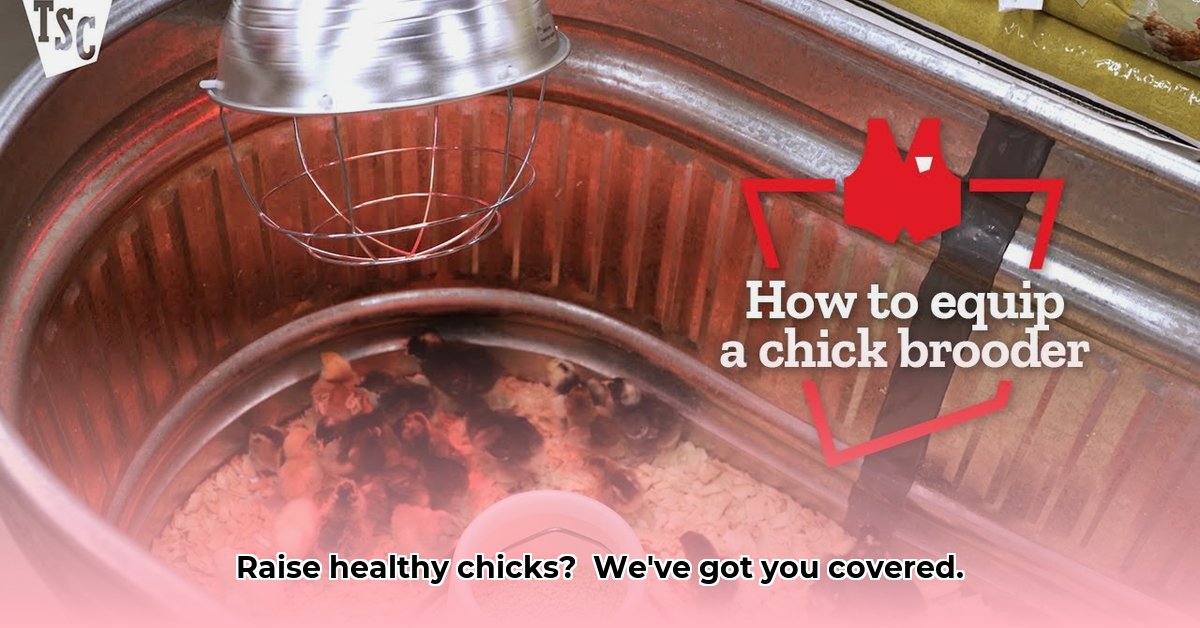
Raising chicks can be a rewarding experience, but ensuring their health and well-being requires careful planning and execution. This guide provides a step-by-step approach to sustainable brooding using readily available resources like Tractor Supply chick brooders. We'll cover everything from selecting the right brooder to daily care and troubleshooting common problems, all while emphasizing environmentally friendly practices. For more information on Tractor Supply brooders, check out this helpful resource: Tractor Supply Brooders.
Choosing the Right Tractor Supply Chick Brooder: Size and Sustainability
The first crucial step is selecting an appropriately sized brooder. Overcrowding leads to stress, disease, and higher mortality rates. Tractor Supply offers various sizes; choosing the correct one depends on the number of chicks. A good rule of thumb is to provide ample space for each chick to move freely without feeling cramped.
Here's a size guideline:
| Number of Chicks | Approximate Brooder Size (square feet) |
|---|---|
| 1-25 | 4-6 |
| 26-50 | 6-8 |
| 51-75 | 8-10 |
Remember, these are estimates. Larger breeds may require slightly more space. Prioritize chick comfort – a slightly larger brooder is better than an overcrowded one. Beyond size, consider sustainability. Look for brooders made from recycled or sustainably sourced materials to minimize your environmental footprint. Isn't it important to raise healthy chicks in a healthy environment?
Setting Up Your Chick Sanctuary: A Step-by-Step Guide
Once you've chosen your brooder, setting it up correctly is critical for ensuring chick health and comfort. This process involves several key steps:
Step 1: Ideal Location Selection: Choose a draft-free location away from direct sunlight and extreme temperature fluctuations. A well-ventilated area is crucial for maintaining air quality and preventing the buildup of ammonia. Don't forget the importance of easy monitoring – you'll want to keep a close eye on those fluffy bundles of joy!
Step 2: Bedding Selection: Use absorbent, non-toxic bedding like pine shavings (avoid cedar shavings as they're toxic to chicks). Aim for a depth of a few inches to absorb waste and provide insulation. Clean bedding daily to maintain hygiene and reduce the risk of disease. How can you ensure your chicks’ hygiene? Daily bedding cleaning is vital.
Step 3: Effective Heating: Chicks need warmth. A dependable heat source, such as a brooder heater (safer and more energy-efficient than heat lamps), is essential. Start with a temperature of approximately 95°F (35°C) for newborns and gradually decrease it by about 5°F per week. Regularly monitor the temperature using a thermometer, your trusty brooding sidekick.
Step 4: Essential Supplies: Provide fresh, clean water in chick waterers designed to prevent drowning. Offer chick starter feed formulated for their nutritional needs. These seemingly small items are essential for your chicks’ health and overall well-being!
Daily Care and Maintenance: A Recipe for Thriving Chicks
Daily care involves consistent monitoring and maintenance to ensure your chicks' health and prevent problems.
- Hygiene First: Remove wet or soiled bedding daily. Regular cleaning prevents disease and maintains a healthy environment.
- Health Monitoring: Daily observation is crucial. Look for signs of illness (lethargy, ruffled feathers, etc.) and isolate any sick chicks immediately.
- Ventilation Check: Ensure adequate ventilation without drafts. Proper airflow prevents moisture buildup and respiratory problems.
- Temperature Regulation: Adjust the temperature based on your chicks' behavior. They'll huddle if it's too cold and spread out if it's too warm.
Troubleshooting Common Issues: Addressing Challenges Head-On
Despite best efforts, issues can arise. Here's how to tackle common problems:
- Temperature Fluctuations: Check your heating element, insulation, and ventilation. Adjust accordingly to maintain consistent warmth.
- Chick Illnesses: Promptly consult a veterinarian if you suspect illness. Early intervention is vital.
- Ventilation Problems: Adjust ventilation openings to improve airflow and prevent ammonia buildup.
Sustainable Brooding: A Holistic Approach
Sustainable brooding goes beyond energy efficiency. Consider these ethical and environmental factors:
- Responsible Feed Sourcing: Opt for locally sourced, ethically produced chick feed to reduce transportation emissions and support local farmers. What are the environmental ramifications of your feed choices? Consider this crucial question.
- Waste Reduction: Use reusable materials whenever possible to minimize waste and environmental impact.
- Durable Brooders: Choose durable brooders constructed from sustainable materials to lengthen their lifespan and reduce the need for replacements.
By implementing these steps, you’ll raise healthy, happy chicks while minimizing your environmental footprint. Remember, responsible and sustainable brooding benefits both your flock and the planet, establishing a successful and ethical foundation for your agricultural endeavors.